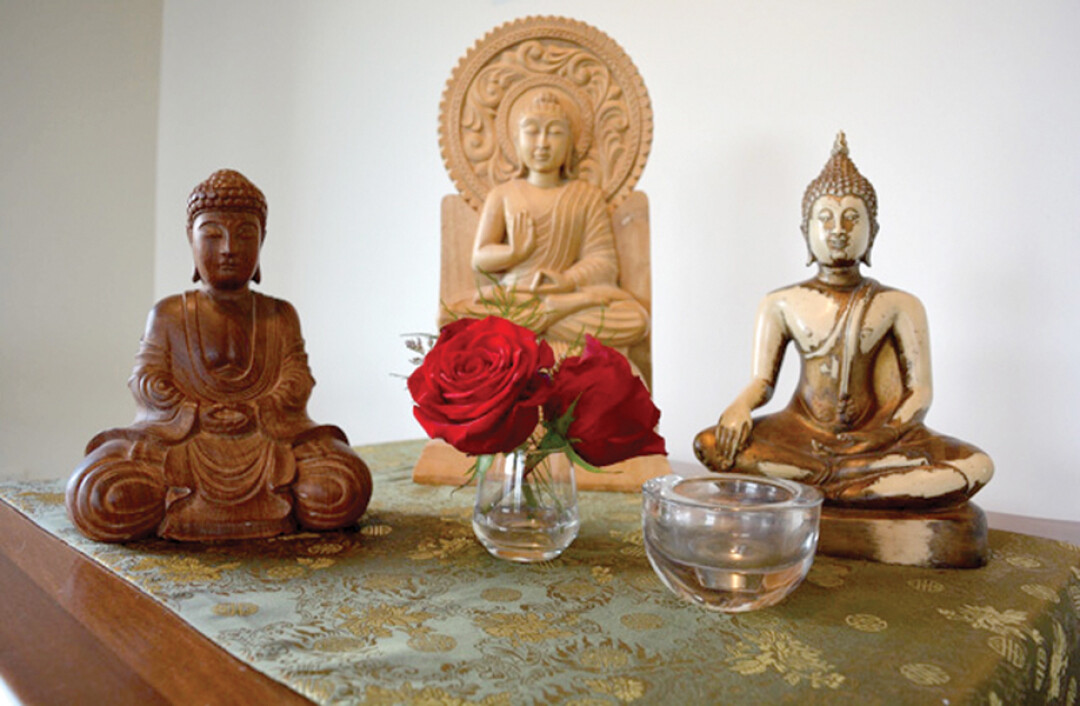Dharma Is a Funny Word

In a culture accustomed to the great monotheistic traditions, we generally expect our places of worship to reflect the magnificence and power written into the creation story. Stained glass, ornate carvings, bell towers, brick and mortar. Solidity. Certainty. Devotion.
Churches are some of my favorite architectural creations, and having spent plenty of time inside them, having understood the reverence they inspire, I appreciate the work that goes into creating a building with the intention of honoring the creator. We see churches everyday and recognize them immediately; sacred space--obvious and dignified--juxtaposed amongst the ordinariness of dental clinics and houses and parks. Basically, they stand out.
So you can imagine my surprise then, when I arrived at The Bozeman Dharma Center on East Main Street for the first time and found no spires or solid oak doors or symbols. Just a simple sign mounted to rustic sheet metal on the left side of a shared professional building.
I wandered through the front door and walked up the stairs. Dharma is a funny word, joining established groups can be overwhelming, and although I had meditation experience, the outside-the-comfort-zone jitters were definitely there. At the top of the stairs, I saw the swinging glass door with the same simple writing, “Bozeman Dharma Center,” and I took a breath. All the expected fears of jumping into a community built on the practice of shedding protection and relating from openness were there. And still, I knew I had to go in.
And once I entered, I was surprised all over again. Instead of the religious icons, altars, and statues I expected, I found a simple, gently-lit room with a stocked library against one wall, a coat rack, and two couches. Instantly, I felt better. This was a normal room, and the subconscious fears of conversion or kool-aid disappeared. A smiling man with dark hair greeted me. “Go ahead and go in and find a seat.”
I nodded, looking past the foyer into the meditation hall. It was a high-ceilinged, inviting room with a simple altar at the front on which sat a statue of the Buddha and a single burning candle. The lights were dimmed, and eight cushions were placed in a circle. I walked in and sat down, bringing my attention to the breath. My body began to relax and the apprehension I was holding evaporated as my shoulders dropped and my breathing deepened. Others arrived in silence, entering the hall with a bow, and walked to their cushions. We sat for forty five minutes, but somewhere around the half-way point, time disappeared. Only the air moving through the nose and the random, floating thoughts of the subconscious remained. The ending bell rippled through my body, more a feeling than a sound, and brought me back to the cushion.
The rest of the night was spent in dialogue, asking and deeply considering a series of questions designed to point the mind toward the inner-truth promised by the Buddha. The first question was “is it possible to listen without an opinion?” and I settled in, listening intently to the bell, investigating the possibility that I could hear it without any secondary ideas. We sat and talked and considered, and as the meeting progressed, a sense of stillness arose. For brief moments, my mind went quiet. When I spoke, the words came more from feeling than thought, moving through me rather than from me. And when I left, wandering easily down those same stairs, a big grin spread across my face.
While there is no single translation of the Sanskrit word “dharma” in English, it is usually taken to mean “the right way of living” or the “way of understanding.” It’s both an experience and a path, a set of teachings and the wisdom those teachings confer. While words aren’t actually the things they attempt to describe, my basic understanding of dharma is a visceral feeling of “the way things really are.” And the internal investigations that happen at Bozeman’s Dharma Center are all based on the goal of contacting that mysterious quality of being that has been described in mystical texts throughout the centuries.
The Bozeman Dharma Center opened its doors in December 2013 and has been growing steadily since. Three resident groups, Dharmata (Tibetan), Insight (Vipassana) and Zen call the center home, each studying and practicing a form of Buddhist teaching. These three are the main Buddhist lineages or “paths” originating from different locations across Asia, and each offers a varied approach to the same goal: Awakening from suffering.
In a way, this is the pursuit of all religions, and perhaps all philosophies in general. How can we live in a way that limits the suffering of ourselves and others to the highest possible degree? Many answers have come forward. Prayer, service, deep thought, material gain, more Facebook friends...the list goes on. Buddhism is neither strictly a religion nor a philosophy. It’s more of a practice. It’s a systematic, behavioral approach meant to help the human mind see through its self-imposed limitations. No beliefs are required to be a Buddhist and in fact, from a Buddhist standpoint, the less one believes, the better.
And this brings me back to the beginning. Buddhism is about negation of everything unreal. Simplicity. Silence. Clarity. It’s about the basic truth of one’s own direct experience. And the gathering places for this sort of inquiry usually reflect such an understanding of the inherent simpleness of life.
If you go looking for The Bozeman Dharma Center, you might miss it--it’s tucked away in the second story of a new and well-designed professional building, across Main Street from Lindley Park--but trust me. It’s there.
To learn more about the Bozeman Dharma Center, or to see a list of groups and upcoming gatherings, visit bozemandharmacenter.org
